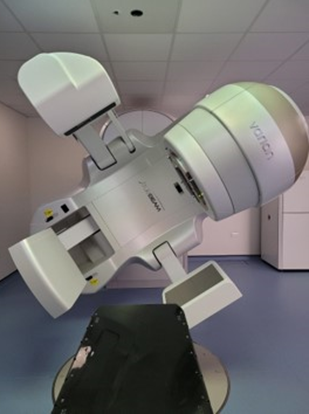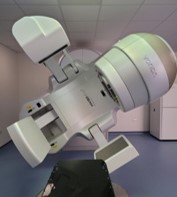
Unlike CT or MRI scanners, Radiotherapy treatment machines, known as Linear Accelerators or LINACS (figure 1) move around you to deliver the treatment. The information below will help you understand what will happen at different points of your treatment.

We will then bring you into one of our treatment rooms. You will be given your appointment list we will answer any questions you may have regarding the treatment.
You will be asked to remove any clothing that covers the area being treated. We will then ask you to lie on a couch in the same position as you did for your CT scan.
Using the tattoos/marks made at your pre-treatment appointment, the radiographers will move the couch and the treatment machine into position. We may need to adjust your position so that you are in the correct place. We will then take measurements to ensure the accuracy of your position.
When you are in the correct place for treatment, we will leave the room. There will be an alarm sound as we leave. When we are outside the room we can always see and hear you, so you can just raise your hand or speak if you need us, and we will come back into the room.
Unlike CT or MRI scanners, Radiotherapy treatment machines, known as Linear Accelerators or LINACS (figure 1) move around you to deliver the treatment. The machine may come very close to you during the session but it will not touch you at any point. There is nothing to see or feel during the treatment, but there may be some beeping and buzzing noises
We will take images of you to compare against the CT planning scan to ensure you are in the correct place for treatment, the images taken are not for diagnostic purposes so can’t evaluate the effectiveness of the treatment.
The first appointment is always the longest appointment as we have extra measurements and checks to perform. The treatment appointment varies but usually takes between 15-30mins and most of the time is spent with the Radiographers in the room with you and the actual treatment itself usually only takes a few minutes to deliver.
All subsequent treatments are the same every day, but appointment times can vary across our service times, speak to a member of the team about your appointment times, if necessary. If your course of treatment is longer than 1 calendar week, we will print weekly appointment lists for you to collect from the main reception desk every Thursday.

The OTR team plays a vital role in supporting you while undergoing radiotherapy, ensuring you receive personalised care throughout your radiotherapy pathway, they can help with:
- Side effect management & prescribing of necessary medications relating to radiotherapy.
- Discussing how you are feeling and address any concerns or queries during your radiotherapy.
- Referrals to any other healthcare services as appropriate.

Radiotherapy may cause a skin reaction within the area of treatment, and it is important to take care of your skin during treatment. Here are some guidelines on treating your skin during Radiotherapy. These apply to the area of the body being treated:
- Wash with warm water, not too hot or cold.
- Use a soap or shower gel of your choice.
- Pat the skin dry, do not rub.
- You can continue to use deodorant.
- Gently apply a moisturiser twice a day to the area of treatment. You can use any moisturiser that is free from Sodium Lauryl Sulphate. Examples- E45, Aveeno cream.
- Do not use moisturiser on broken skin, so if your skin breaks stop using moisturiser on the area and let us know and we can give you a different cream to help heal the broken area.
- Wear loose cotton clothing to avoid extra irritation.
Energy Levels
It is very common for patient to feel more tired than usual during a course of Radiotherapy treatment.. Here are some steps you can take to help manage your energy levels:
- Aim to eat well during your treatment and drink about two litres of fluid (water or squash) per day, limiting caffeine and alcohol intake.
- Listen to your body and rest if you need to but continue your day-day activities if you feel able.
- Light, gentle exercise such as walking and swimming.
